Tim Olk’s book entitled Northern Illinois Fire Ground Photography is almost here!



Download the flyer.
Apr 11
Posted by Admin in Fire Service News, Fire Service Photos | Comments off
Tim Olk’s book entitled Northern Illinois Fire Ground Photography is almost here!



Download the flyer.
Tags: Chicago Fire Department apparatus photos, fire engine photos, fire scene photos, firefighter photos, historic fire photos, historic truck photos, historical photos of Chicago Fire Department, new book about fire departments, Northern Illinois Fire Ground Photography, photos of fire fighters working, photos of fire in Chicago, photos of fire trucks at fire scene, photos of firefighters battling house fire, photos of house fire, Tim Olk
Apr 11
Posted by Admin in Fire Service News | Comments off
This from Bill Post:
Yesterday the National Institute of Standards and Technology released a high rise fire fighting study at the Metropolitan Fire Chiefs conference meeting in Phoenix Arizona. The Chicago Fire Fighters Union Local 2 has already cited it in an effort at negotiations with the city as to why the Chicago Fire Department can’t afford to cut crew size.
The Chicago Fire Department’s union chief on Wednesday brandished a new federal report on fighting high-rise fires to push back against potential job cuts as part of protracted labor negotiations with Mayor Rahm Emanuel’s administration.
The study by the U.S. Commerce Department, the national firefighters union and other organizations focused on response times to blazes in 13-story buildings and found that crews of five or six firefighters put out fires and conducted search-and-rescue operations “significantly faster” than three-person or four-person teams.
The Fire Department contract that lapsed in June requires five firefighters per truck, but Emanuel has left open the possibility of reducing staffing levels. There has been little progress in negotiations since then, but firefighters must work under the old rules for now.
While most of Chicago’s high-rises are concentrated downtown and along the lakefront, Firefighters Union Local 2 President Thomas Ryan argued that other large buildings like schools and factories are found throughout the city and present many of the same challenges. He argued that the report “scientifically proves what we’ve been saying for years” and said cutting the number of firefighters at any firehouse in the city would put the public at risk.
Administration spokesman Bill McCaffrey said high-rise fires are relatively infrequent, so the report represents “a very small portion of properties and fires in the city.”
“And Chicago has highly skilled and well-equipped high-rise response teams, a recently rewritten high-rise response protocol and strict requirements for fire safety in high-rises — these are the most critical factors in maintaining safety in high-rises in Chicago,” McCaffrey said in an email.
Information about the study can be found HERE. Excerpts from the press release:
Landmark High-Rise Fire Study Evaluates Effectiveness of Crew Sizes, Elevator Use
PHOENIX – When responding to fires in high-rise buildings, firefighting crews of five or six members—instead of three or four—are significantly faster in putting out fires and completing search-and-rescue operations, concludes a major new study* carried out by the National Institute of Standards and Technology (NIST), in cooperation with five other organizations.
Results of the study, carried out with 13 Washington, D.C.-area fire departments, were presented today at the 2013 Metropolitan Fire Chiefs Conference in Phoenix.
“Unlike most house fires, high-rise fires are high-hazard situations that pose unique operational challenges to fire service response. How big a fire gets and how much danger it poses to occupants and firefighters are largely determined by crew size and how personnel are deployed at the scene,” says lead researcher Jason Averill, a NIST fire protection engineer. “It’s not simply that larger crews have more people. Larger crews are deployed differently and, as a result, are able to perform required tasks more quickly.”
An analysis of 14 “critical tasks”—those undertaken when potential risks to building occupants and firefighters are greatest—found that three-member crews took almost 12 minutes longer than crews of four, 21 minutes longer than crews of five, and 23 minutes longer than crews of six to complete all tasks. Four-person crews took nine minutes and 11 minutes longer than five- and six-member crews, respectively.
The study also looked at the effect of using fire service access elevators to move firefighters and equipment up to the staging floor and concluded that most tasks were started two to four minutes faster when using the elevators compared with using the stairs.
On the basis of the results of computer modeling, which incorporate data from live experimental burns, the study team concluded that smaller crews end up facing larger fires because of the additional time required to complete tasks.
A three-person crew, for example, would battle a medium-growing blaze that is almost 60 percent larger than the fire faced by a six-member crew, which would start extinguishing a fire roughly three-and-one-half minutes earlier. In an office building, this difference is equivalent to four employee cubicles on fire for a three-person crew versus two cubicles for a six-person crew.
Comparing the performances of different-sized crews, the researchers found that adding two members to three- and four-person teams would result in the largest improvements in starting and completing critical tasks, such as advancing the water hose to the fire location and beginning search and rescue. Improvements ranged from one minute to 25 minutes, depending on the task.
The research team also evaluated whether dispatching more three or four-member crews to a high rise fire—accomplished by sounding a higher initial alarm—would be as effective as sending a low first alarm contingent of engines and trucks staffed by more firefighters. They found that a “low-alarm response with crews of size four or five outperforms a high-alarm response with crew sizes smaller by one firefighter.”
“Prior to this experiment, some fire departments attempted to deploy with smaller crews on each piece of apparatus,” explains Lori Moore-Merrell of the International Association of Fire Fighters, a co-principal investigator for the study. “The logic suggested that, if the fire is big enough, just send more units, but it ignores the fact that larger crews have tactical advantages that reduce risk exposure to people and firefighters. Crews of six and even five can carry out crucial tasks in parallel rather than in series. Saving time can save occupant lives and prevent firefighter injuries and property damage.”
The National Fire Protection Association (NFPA) defines high-rises as buildings that are seven stories or taller, the height that exceeds most types of fire service ladders. In most U.S. communities, new high- rises are required to have automated sprinkler systems, which are designed to control the spread of fires, not to extinguish them.
But according to the NFPA, 41 percent of U.S. high-rise office buildings, 45 percent of high-rise hotels, and 54 percent of high-rise apartment buildings are not equipped with sprinklers, as compared with 25 percent of hospitals and related facilities. Moreover, sprinkler systems fail in about one in 14 fires.
While much less frequent than house fires, about 43 high-rise fires occur in the United States every day. Between 2005 and 2009, according to the NFPA, high-rise structure fires averaged 15,700 annually. Average annual losses totaled 53 civilian deaths, 546 civilian injuries and $235 million in property damage.
Tags: 2013 Metropolitan Fire Chiefs Conference, Chicago Fire Department, Chicago Firefighters Union Local 2, Firefighters Union Local 2 President Thomas Ryan, fires in high-rise buildings, Landmark High-Rise Fire Study Evaluates Effectiveness of Crew Sizes, National Institute of Standards and Technology, NIST, The National Fire Protection Association (NFPA)
Apr 11
Posted by Admin in Fire Department News, Fire Truck photos, New Delivery | 8 Comments
Dan McInerney submitted an image of a new tower ladder for Aurora Truck 6. It is a 2012 E-ONE Cyclone II 95′ rear mount with no pump and no water tank. The job # is 137594.

Aurora Truck 6 has a new 2012 E-ONE Cyclone 95′ tower ladder. Dan McInerney photo
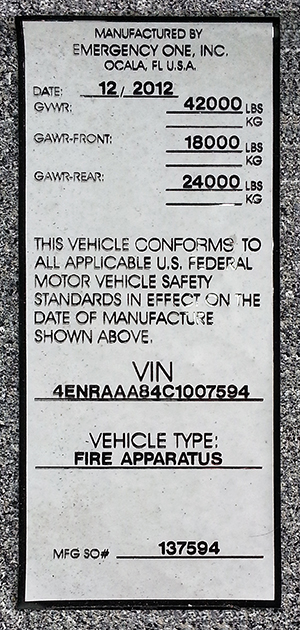
Tags: aluminum tower ladder, Aurora FD Truck 6, Aurora Fire Department, Dan McInerney tower ladder without pump and water tank, new tower ladder in Aurora
Apr 11
Posted by Admin in Ambulance photos, Fire Department History, Fire Department News, Fire Truck photos, New Delivery | 1 Comment
As posted previously HERE and HERE, the Glenview Fire Department took delivery of a new quint for Truck 14. The web site has been updated to show the new truck, though it’s not expected to be in service until June. Here are some additional images of the new Truck 14 and a comparison shot of the previous Truck 14, which will become Truck 14R/Truck 29.

Glenview Truck 14 will be assigned this 2013 Pierce Arrow XT 1500/450/10/40 105′ rear mount quint. Larry Shapiro photo
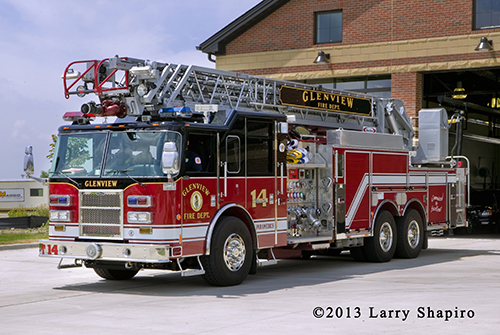
2003 Pierce Dash 1500/450/30/30 105′ quint. Larry Shapiro photo
The Village of Northfield reportedly contributed $100,000 towards the purchase of this new unit. In return for that investment, Truck 14R will be housed at Northfield Station 29. It will run as Truck 29 for responses where Northfield is due out of town with a truck. Glenview will respond into Northfield for alarms and fires. When Glenview Truck 14 is out of service for any reason, the older unit will return to Glenview as Truck 14.
There are a few differences between the new unit and it’s predecessor. They include:
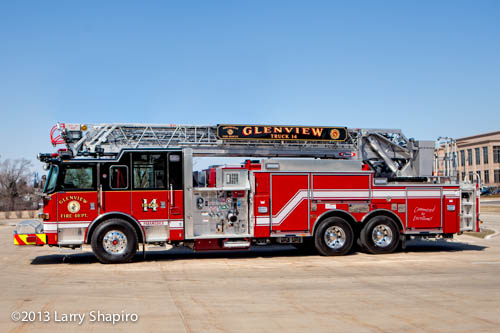
The new truck is slightly longer than the previous unit. Larry Shapiro photo

The extended front bumper houses the Hurst high-pressure cutter and spreader. Larry Shapiro photo
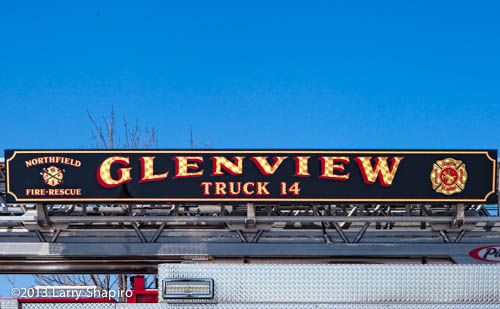
The sign board on the new truck has decals for both GLenview and Northfield. Larry Shapiro photo
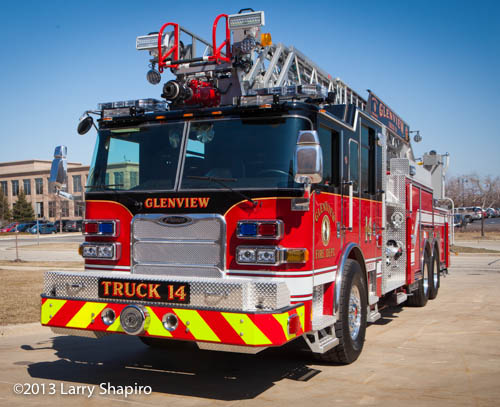
Arrow XT cab. Larry Shapiro photo
Glenview also recently put a new ambulance in service at Station 6. Having purchased one of the last Medtec units prior to the shutdown, they have a 2013 Type I Medtec on an IHC 4300 chassis similar to the rest of their ambulances. The new unit has LED lighting and a slightly different paint scheme on the box that features black near the roof. This replaces the 2007 IHC/Medtec from Station 6 which has become the spare ambulance. The previous spare, a 2001 Freightliner FL60/Road Rescue has been disposed of.
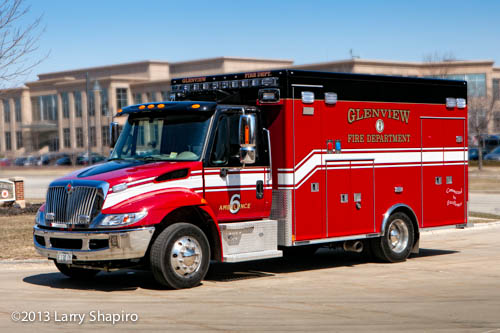
Glenview Ambulance 6 received this 2013 IHC 4300/Medtec with a black border on the box which required a change in the lettering. Larry Shapiro photo
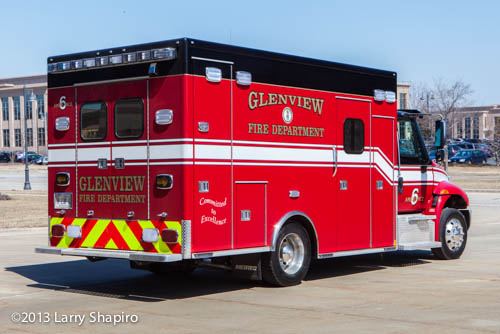
Rear view of the new Ambulance 6 in Glenview showing the chevron striping. Larry Shapiro photo
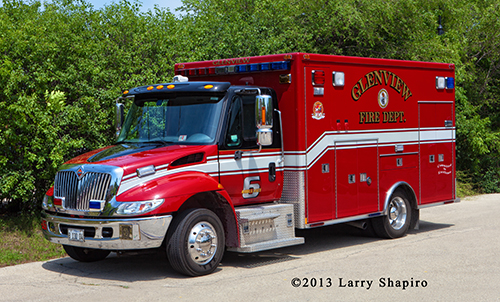
The unit previously assigned to Ambulance 6 is now the spare. This shows the design of the other ambulances in Glenview with an all-red body. Larry Shapiro photo
Tags: ambulance photos, fire departments cooperate to save money, fire departments share cost of new ladder truck, Glenview Fire Department, Hurst high pressure cutter and spreader, IHC 4300 Type I ambulance, Larry Shapiro, Medtec Ambulance, Medtec Type I ambulance, new ambulance photos, new Medtec ambulance for Glenview, Northfield Fire Department, Northfield Fire Rescue, Northfiled Fire contributes to the cost of new Glenview truck, Pierce Arrow XT quint, the last ambulances to be built by Medtec
You are currently browsing the archives for Thursday, April 11th, 2013

For the finest department portraits and composites contact Tim Olk or Larry Shapiro.
Arclite theme by digitalnature | powered by WordPress